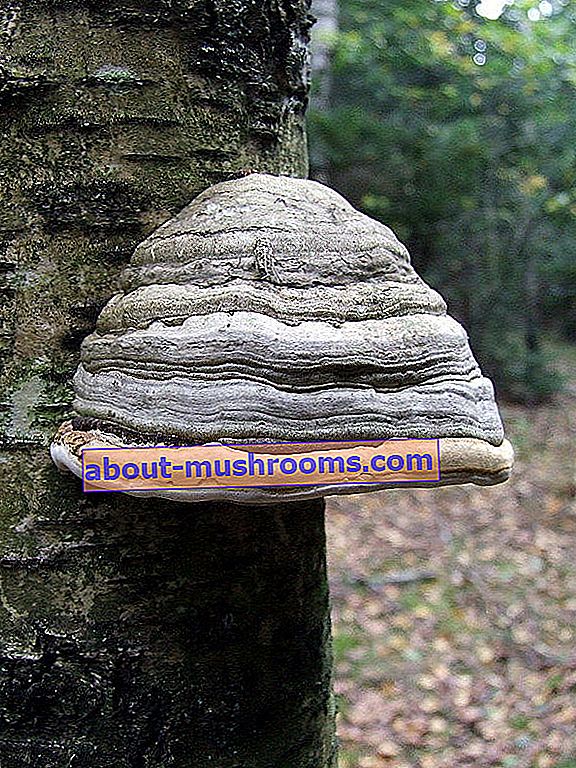True polypore (Fomes fomentarius)
Systematics:- Department: Basidiomycota (Basidiomycetes)
- Subdivision: Agaricomycotina (Agaricomycetes)
- Class: Agaricomycetes (Agaricomycetes)
- Subclass: Incertae sedis (undefined)
- Order: Polyporales
- Family: Polyporaceae (Polyporous)
- Genus: Fomes (Tinder)
- Species: Fomes fomentarius (Polypore real)
Synonyms:
- Blood sponge;
- Polyporus fomentarius;
- Boletus fomentarius;
- Ungulina fomentaria;
- Fomes griseus.

True polypore (Fomes fomentarius) is a mushroom from the Coriolaceae family, belonging to the Fomes genus. Saprophyte, belongs to the class of Agaricomycetes, the category of Polyporovs. Widely distributed.
External description
The fruiting bodies of the present tinder fungus are perennial, in young mushrooms they have a rounded shape, and in mature ones they become hoof-like. The fungus of this species does not have legs, therefore the fruiting body is characterized as sedentary. Connection to the surface of the tree trunk occurs only through the central, upper part.
The cap of the described species is very large, in ripe fruit bodies it is up to 40 cm wide and up to 20 cm high. The peel of the fruit body is wavy, characterized by unevenness, dullness and a darker shade in the area of the depressions. Cracks can sometimes be seen on the surface of the fruiting body. The color of the mushroom cap can vary from light, grayish, to rich gray in mature mushrooms. Only occasionally the shade of the cap and fruiting body of a real tinder fungus can be light beige.
The flesh of the described mushroom is dense, corky and soft, sometimes it can be woody. When cut, it becomes velvety, suede. By color, the flesh of the present tinder fungus is more often brownish, deep reddish-brown, sometimes nutty.
The tubular hymenophore of the fungus contains light, rounded spores. When you press on it, the color of the element changes to a darker one. The spore powder of this tinder fungus is white and contains spores of 14-24 * 5-8 microns in size. they are smooth in structure, oblong in shape, and have no color.
Season and habitat of the fungus
Tinder fungus belongs to the category of saprophytes. It is this fungus that is the main cause of the appearance of white rot on the trunks of deciduous trees. Due to its parasitism, thinning and destruction of wood tissue occurs. The fungus of this species is widespread enough on the territory of the European continent. You can see it everywhere in many European countries, including Russia. The real tinder fungus parasitizes mainly on deciduous tree species. Plantings of birches, oaks, alder, aspen, and beeches are often exposed to its negative impact. You can often find the real tinder fungus (Fomes fomentarius) on dead wood, rotten stumps and dead trees. However, it can also affect very weak, but still living deciduous trees. Living trees are infected with this fungus through breaks in the branches,cracks in the trunks and in the bark.
Edibility
The mushroom is inedible
Similar types and differences from them
There is no similarity with other varieties of mushrooms in this tinder fungus. The characteristic features of this fungus are the shade of the cap and the attachment features of the fruiting body. Sometimes inexperienced mushroom pickers confuse this tinder fungus with a false tinder fungus. However, a feature of the described type of mushrooms is the ability to more easily separate the fruiting body from the surface of the tree trunk. This is especially noticeable if the separation is done manually, from the bottom up.

Other information about the mushroom
The main feature of the present tinder fungus is the presence in its composition of medicinal components that can prevent the development of cancerous tumors in the human body. In essence, this mushroom can be used for effective prevention and treatment of cancer in the early stages.
Fomes fomentarius, as already noted, is a parasite, and therefore always causes irreparable harm to agriculture and park landscape. The trees affected by it gradually die, which is bad for the beauty of the surrounding nature.
The history of the use of a mushroom called tinder fungus is quite interesting. In ancient times, this mushroom was used to produce tinder (a special material that can be ignited without effort, even with a single spark). This component was also found during excavations in the equipment of the Ötzi mummy. The inner part of the fruiting body of the described species is often used by traditional healers as an excellent hemostatic agent. Actually, it is thanks to these properties that the mushroom is popularly called "blood sponge".
Sometimes tinder fungus is used as a component in the handicraft production of souvenir products. Beekeepers use dried polypores to light a smoker. Several decades ago, this type of mushroom was actively used in surgery, but now there is no practice of using a real tinder fungus in this area.

